Physical Causes of ED
Confusion around ED
Coronary Artery Disease and ED
What is Endothelial Dysfunction?
The common link between ED and ED
The Focus on Viagra
All About Nitric Oxide (NO)
The Focus on ADMA
The Focus on Low Testosterone
Lifestyle Changes for Improvement
The Value of Asking Why
What is a good erection?
- Predictable — To know what to expect
- Dependable — To be ready when needed
- Suitable — To be of the quality needed
- Sustainable — To last for the needed duration
- Disposable — To go away when on schedule
- Reusable — To return at a moment’s notice
Figure 1 illustrates the many causes of anxiety that may result psychogenic erectile dysfunction.
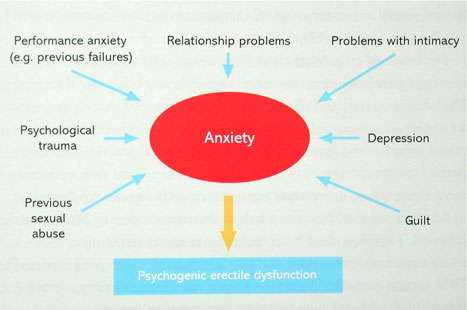
Physical Causes of ED
- Diabetes
- Heart disease
- Medications
- Spinal injury
- Hormone imbalance
- Surgery (Prostate)
- Radiation Therapy
Figure 2 is a graphic representation of the major causes of ED. As shown, the leading causes are diabetes and vascular disease.
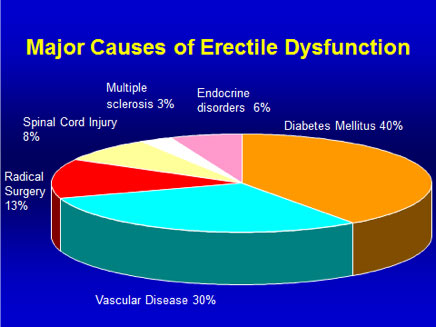
As illustrated in Figure 3, ED does increase in frequency and severity with age.
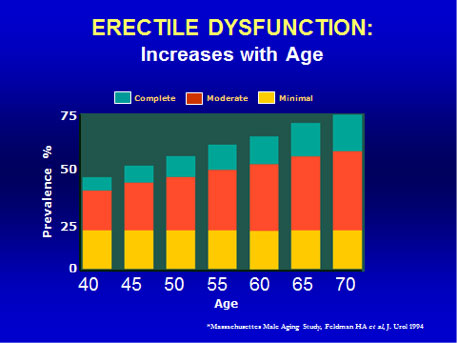
Confusion around ED
There are a number of misunderstandings associated with ED:
- It’s all in the mind.
- My partner thinks I don’t love her anymore.
- Nothing can be done about it.
- It’s an old man’s problem.
Several studies, such as the one cited below, show that ED may be a symptom of undiagnosed cardiovascular disease.
“Besides the functional impairment associated with the presence of ED for which patients present to their practitioner, the latter may be an important sentinel symptom for an underlying undiagnosed cardiovascular disease. Remarkably, up to 70% of patients with new onset angina pectoris and angiographically verified coronary artery report a history of ED.” (J Am Coll Cardiol. 2011;58(13):1378–85)
Another study suggested ED signals increased risk of dying over a 2.8-year period.
“Rather than causing heart disease, erectile dysfunction is more likely to be a symptom or signal of underlying ‘silent’ heart disease and could in future become a useful marker to help doctors predict the risk of a cardiovascular problem. This is a sensitive topic but men shouldn’t suffer in silence; there are many effective treatments, both for erectile dysfunction and for cardiovascular disease.” (PLoS Medicine January 29, 2013)
Thus, many medical professionals share the following opinion:
“The recognition of ED as a warning sign of silent vascular disease has led to the concept that a man with ED and no cardiac symptoms is a cardiac (or vascular) patient until proven otherwise.” (Princeton II: Jackson G et al. 2006. J Sex Med 3:28-36)
Coronary Artery Disease and ED
“Epidemiological studies show that nearly 75% of men with coronary artery disease also have ED. Vascular and cavernosal smooth muscle dysfunction appear to share the same risk factors, and ED may be an early signal of impending cardiovascular problems.” (Heart 2003;89 251–3 J Urol 2003; 170S46–50)
The risk factors for coronary heart disease and ED are similar, as shown previously in Figure 2.
The risk factors for coronary artery disease and ED are similar, as shown in Figure 4.
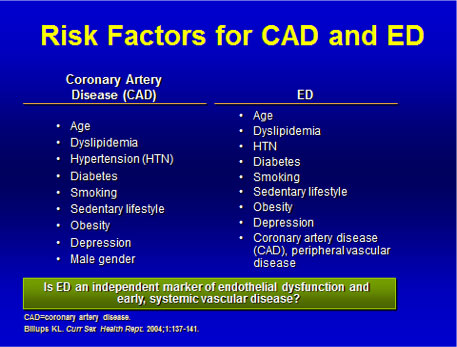
One cause is the diameter of penile artery being very small, only 1-2 mm. The next smallest arteries are the coronary arteries as shown in Figure 5.
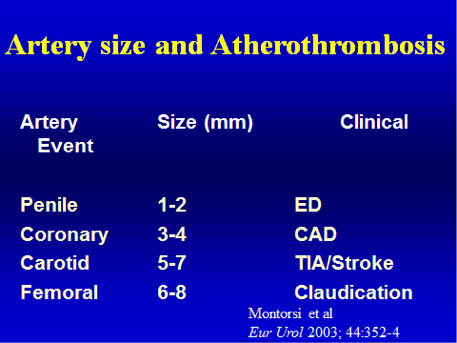
As the penile arteries become diseased and dysfunctional, the next arteries to become dysfunctional are the coronary arteries, unless the cause of the dysfunction is determined and corrected.
ENDOTHELIAL DYSFUNCTION (ED) IN ERECTILE DYSFUNCTION (ED) ED = ED
What is Endothelial Dysfunction?
Endothelial cells line the inside of every blood vessel in the body. They form a one-cell-thick layer called the endothelium, which is also found on the inner walls of the heart chambers and lymphatic vessels that carry excess blood plasma around the body. The endothelium is very extensive. If all the endothelium tissue in an adult body were to be spread out, it would take up the area of eight tennis courts! The vascular endothelium serves multiple functions:
- It regulates fluid and molecule traffic between blood and tissues.
- It is an anti-coagulant surface.
- It contributes to vascular homeostasis and repair.
- It plays a vital role in vascular tone and blood flow regulation.
According to an article published in Int J Biol Sci. 2013; 9(10): 1057–1069, “Alterations of endothelial cells and the vasculature play a central role in the pathogenesis of a broad spectrum of the most dreadful of human diseases, as endothelial cells have the key function of participating in the maintenance of patent and functional capillaries. The endothelium is directly involved in peripheral vascular disease, stroke, heart disease, diabetes, insulin resistance, chronic kidney failure, tumor growth, metastasis, venous thrombosis, and severe viral infectious diseases. Dysfunction of the vascular endothelium is thus a hallmark of human diseases.”
Figure 6 illustrates the causes and consequence of endothelial dysfunction.

The common link between ED and ED
Nitric Oxide (NO), which is produced by the endothelial cells.
What does Endothelial NO do?
- Causes smooth muscle relaxation and vasodilatation — maintenance of basal vasomotor tone
- Essential for regulation of blood pressure
- Reduces proliferation of vascular smooth muscle
- Protects blood vessel intima from injurious consequences of platelet aggregation-inhibition of thrombosis by inhibiting platelet adhesion, activation and agonist-induced secretion.
Figure 7 explains how an erection occurs.
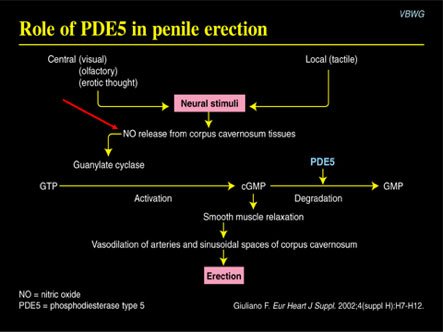
It is not important to remember all these chemicals, just the concept of how an erection occurs. It begins with neuronal stimulation, which may be central from visual, olfactory, or erotic thought(s) or local when tactile stimulation occurs. Neural stimulation causes the release of NO from the portion of the penis called the corpus cavernosum. That stimulates a chemical called guanylate cyclase, which converts GTP to cyclic GMP. Cyclic GMP causes smooth muscle relaxation, with vasodilation of arteries and sinusoidal spaces of the corpus cavernosum producing an erection. Thus, a lack of NO causes the entire process to come to a halt, causing ED. Endothelial dysfunction results in decreased NO production and ED, so endothelial dysfunction = erectile dysfunction. (See more about NO below.)
Doesn’t it make sense that when health professionals are trying to resolve ED problems, they must evaluate and resolve all the conditions that contribute to endothelial dysfunction? After all, ED is not a Viagra deficiency!
The Focus on Viagra
How does Viagra work? Look at Figure 8. Unless cGMP is activated, there is no erection. Since an enzyme called phosphodiesterase 5 degrades cGMP, all Viagra and similar drugs do is inhibit that enzyme so cGMP remains active and the erection occurs and persists. Viagra treats the symptoms and not the root cause! Does it resolve the problem of endothelial dysfunction and resulting decreased NO production? No! Should healthcare professionals wait until their patients develop angina (chest pain) or shortness of breath, or have a fatal heart attack, before turning their attention to resolving the problem of endothelial dysfunction? No again.
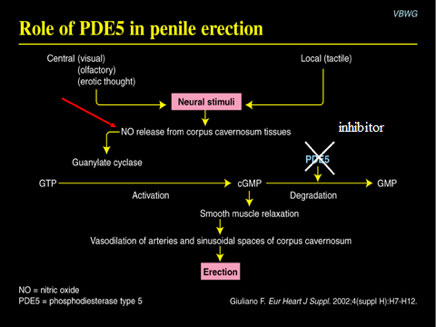
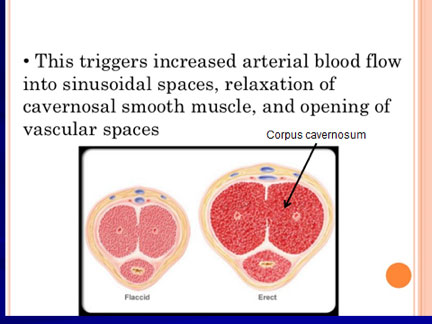
All About Nitric Oxide (NO)
NO is an important messenger molecule involved in many physiological and pathological processes. It plays both destructive and protective roles in autoimmunity, depending on which isomer is expressed. (An isomer means there is more than one type of NO.)
Look at Figure 10.
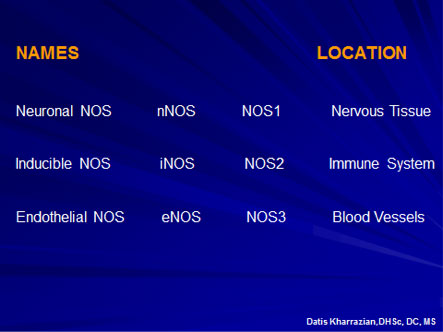
The goal is to have balance of all three types of NO: nervous system, blood vessels (the type required for normal erections) and immune function. Look at the benefits of proper balance in Figure 11 and Figure 12.
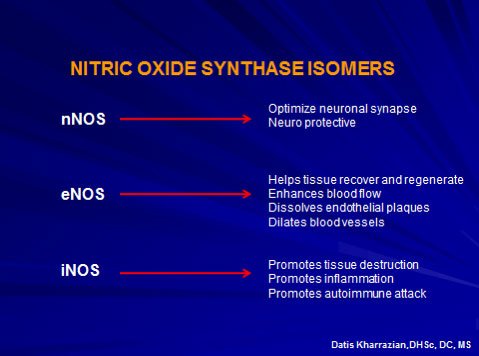
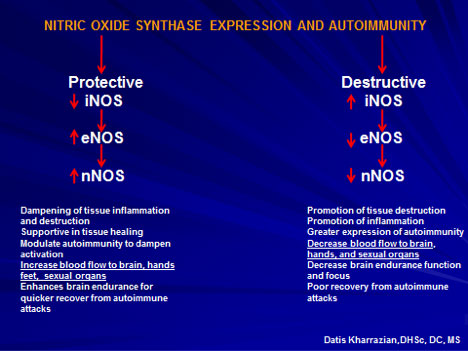
Ideally, you would want to be on the protective side of the benefits listed above. However, if you’re currently involved in an inflammatory process or have an autoimmune disorder that’s being treated inappropriately, the vascular (eNOS) will be suppressed and the risk of ED will be increased.
The Focus on ADMA
Something that suppresses all three types of NO is ADMA (Asymmetric dimethylarginine); it’s well established in the literature that ADMA inhibits all three types of NO. Your ADMA level can be determined by a simple blood test. A blood test for ADMA is essential in the evaluation for anyone with ED.
ADMA is a better predictor of insulin resistance than any other marker. It’s a better predictor of vascular endothelial impairment than cholesterol.
Homocysteine increases in proportion to ADMA. The inhibition of NO synthesis may explain why homocysteine has been associated with impaired endothelium-mediated NO-dependent vasodilatation. Elevated homocysteine increases the potential for strokes by 42% and heart attacks by 30%. In pre-clinical and clinical studies, hypercholesterolemia, hyperglycemia, hypertriglyceridemia or hyperhomocysteinemia have been found to elevate ADMA. MTHFR Support has been used to decrease homocysteine levels.
If you have ED, hypertension, heart disease, abnormal cholesterol or elevated homocysteine, you need to know if your ADMA level. Cardiac Essentials is effective on cholesterol levels as well as Berberine, and VascuGuard.
If you are being evaluated for ED, and your healthcare professional suggests you first try some Viagra, Levitra or Cialis without a proper evaluation, insist on a complete evaluation, including an ADMA level.
The Focus on Low Testosterone
Does low testosterone cause an increase in ED? A study published in Urology (2015 Dec 29. pii: S0090-4295(15)01182-6) came to the conclusion that men with ED and elevated BMI, advanced age, and/or infrequent sexual activity appear to be at high risk of low testosterone, and such patients represent excellent potential candidates for targeted testosterone therapy. Several other studies have come to the same conclusion.
The health consequences of low testosterone include an increased risk of:
- Type 2 Diabetes
- Metabolic Syndrome
- Stroke
- Dementia
- Heart Disease
- Frailty Syndrome
- Inflammation
- Cancer
See testosterone section for more details. Natural ways of increasing testosterone is with Testostormone.
Standard Therapy for Erectile Dysfunction
PDE-5 inhibitors (Viagra, Levitra, Cialis)
As noted in Figure 13, these popular drugs — the first line of therapy — inhibit the breakdown of cGMP, produced from GTP that was stimulated by NO. It should be noted that:
- The PDE-5 isoenzyme is rich in the penis.
- These drugs are contraindicated in patients on nitrates
- There is a relative contraindication in patients with ischemic coronary disease and heart failure.
- These drugs are effective in patients with organic, psychogenic and mixed ED.
- These drugs are effective in 70-80 of patients based on numerous trials.
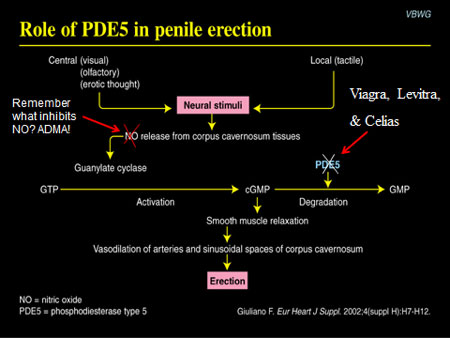
Lifestyle Changes for Improvement
Making some of the following lifestyle modifications can have a position effect on ED:
- Get Regular Exercise
- Eat a Healthy Diet
- Stop Smoking
- Limit Alcohol
- Bicycle With an Ergonomic Saddle
Medications Implicated in ED
Be aware that the following medications may contribute to ED:
Testosterone Production Inhibitors
- Spironalactone
- Ketoconazole
- Metronidazole
- Flutamide
- Cimetidine
- Cyproterone
GnRH Inhibitors
- Progesterone
- Estrogen
- Lupron
- Prolactinoma
- Phenothiazines
- TCAs
- Reserpine
- Cocaine/opioids
Hormonal Therapy
See Testosterone Therapy
The vacuum erection device is pictured below
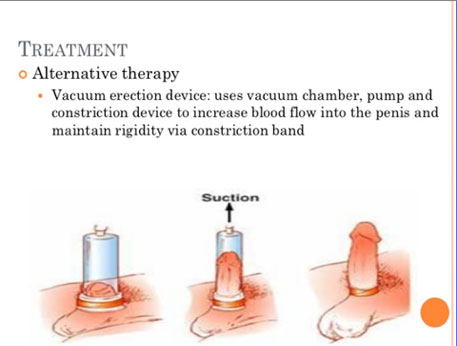
Intracavernosal injection is shown in the diagram below.
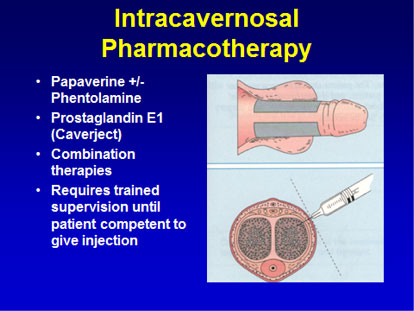
The Value of Asking Why
Of all the articles I read preparing this information, not one said, “First you must do an extensive workup to determine the cause of the problem, and then prescribe the appropriate therapy.” The role of the functional medicine physician is to always ask why. It’s time-consuming and difficult, but it’s the right thing to do!
Bioflavanoids help support healthy blood vessels that are needed for erections. They help prevent the free radicals caused by lipid perioxidation.
Vitamin D deficiency is associated with an increased prevalence of erectile dysfunction independent of arteriosclerotic cardiovascular risk factors.
Magnesium deficiency has been linked to erectile dysfunction.
Methylation is essential for the proper metabolism of testosterone.
Vitamin D deficiency is associated with an increased prevalence of erectile dysfunction independent of arteriosclerotic cardiovascular risk factors.
Supports healthy testosterone metabolism.
Helps prevent vascular inflammation.
Erectile dysfunction has been found in recent years to be a symptom of zinc deficiency.
Helps prevent lipid perioxidation that can damage blood vessels.

About the Author
Douglas C. Hall, M.D.
Dr. Douglas Hall, was born in Indianapolis, Indiana on Jan. 30, 1941. He received his BS and Doctor of Medicine at the University of Florida, training in obstetrics and gynecology. Dr. Hall has been in private practice since 1974 and currently has a large practice in Ocala, specializing in OB/GYN and Functional Medicine.

